Unit 1 Art Reading and Thinking 1 课件(30张,内嵌音频)人教版(2019)选择性必修 第三册
文档属性
| 名称 | Unit 1 Art Reading and Thinking 1 课件(30张,内嵌音频)人教版(2019)选择性必修 第三册 | 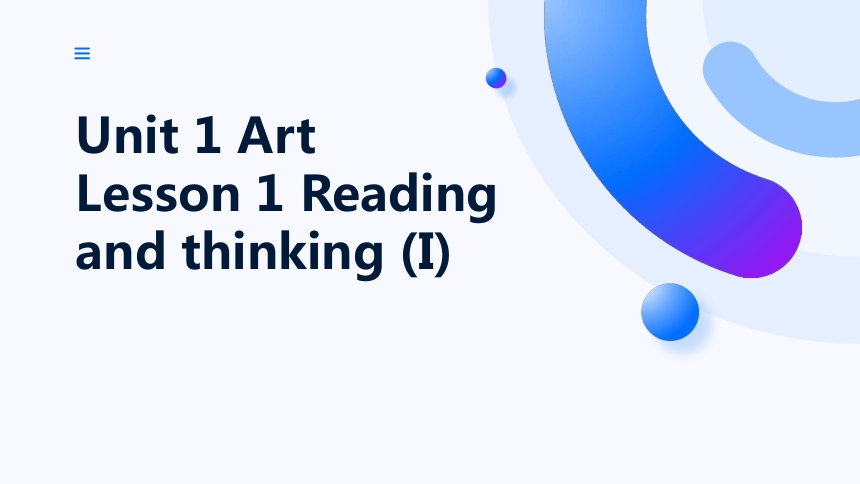 | |
| 格式 | pptx | ||
| 文件大小 | 14.3MB | ||
| 资源类型 | 教案 | ||
| 版本资源 | 人教版(2019) | ||
| 科目 | 英语 | ||
| 更新时间 | 2025-03-05 09:27:29 | ||
图片预览

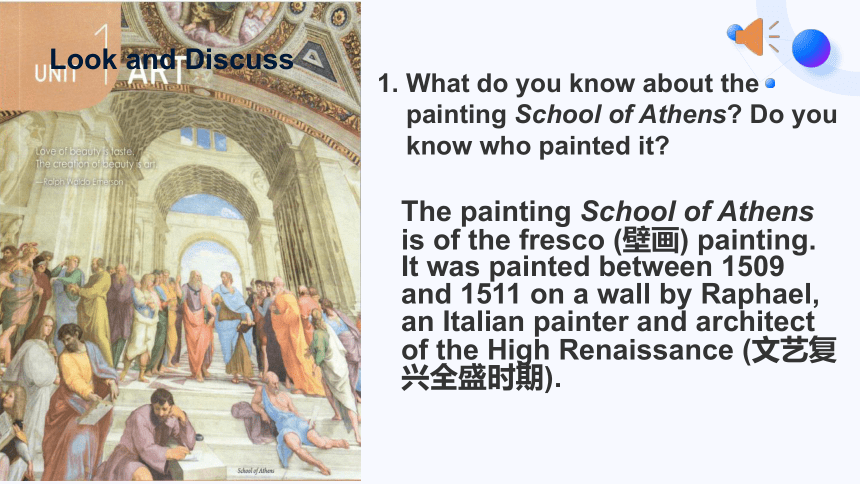
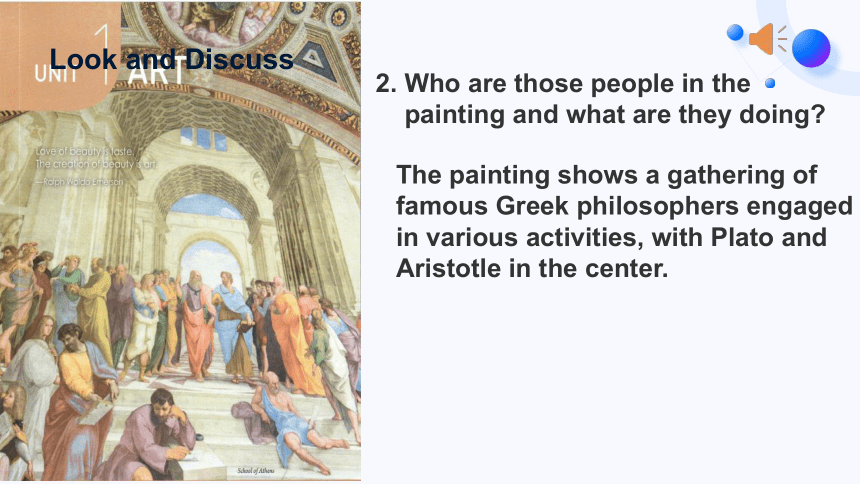
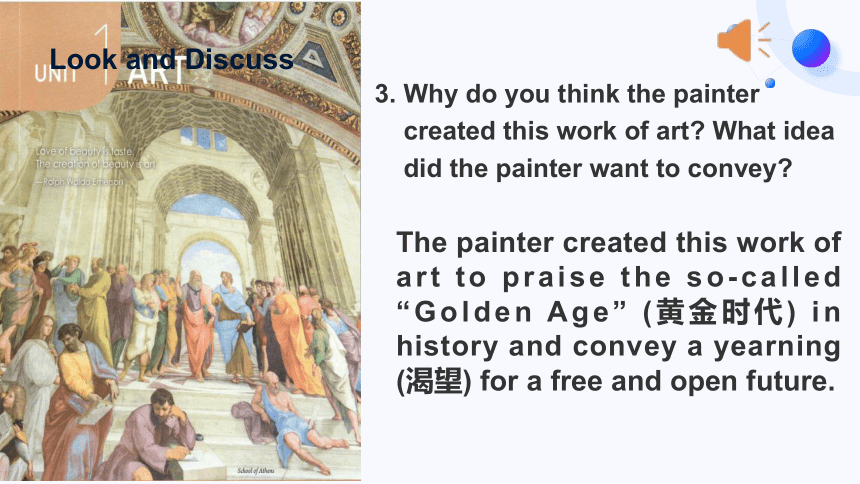
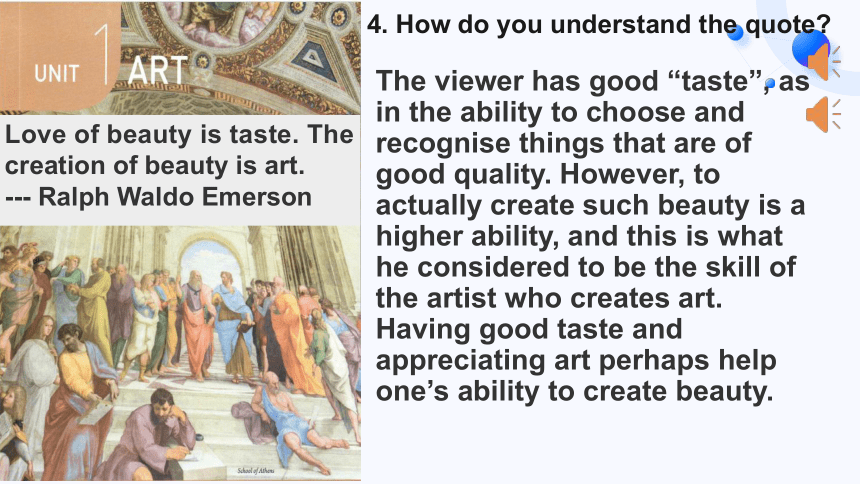
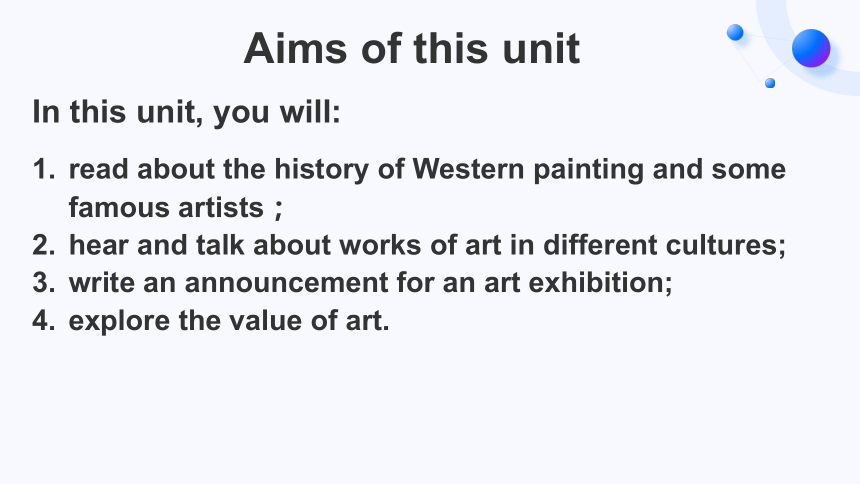
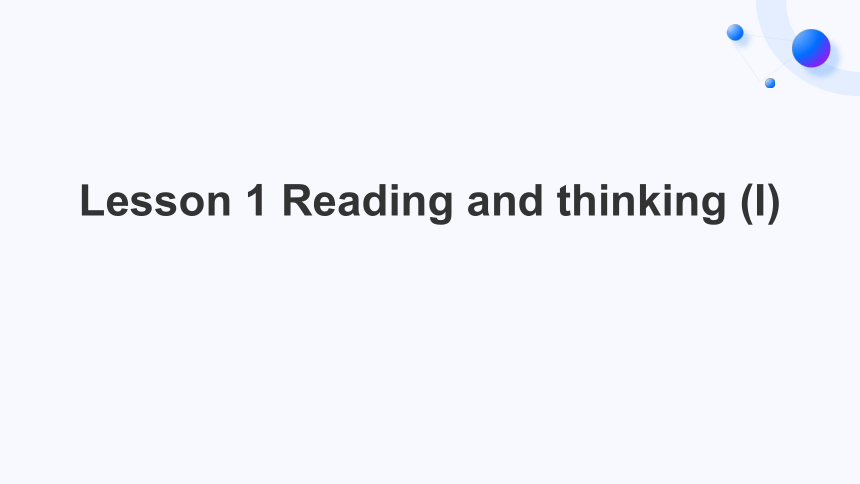
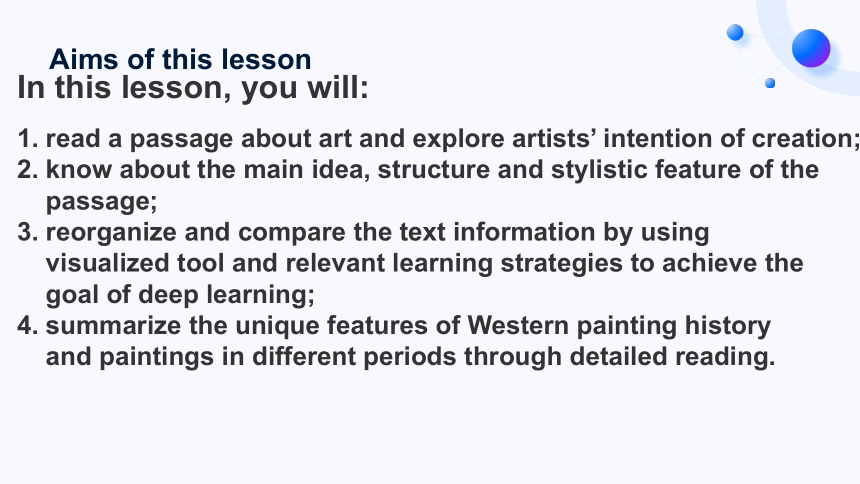
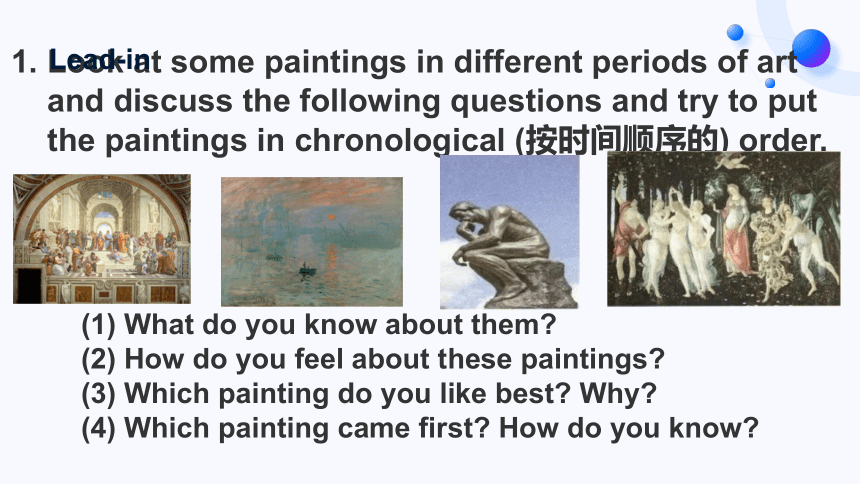
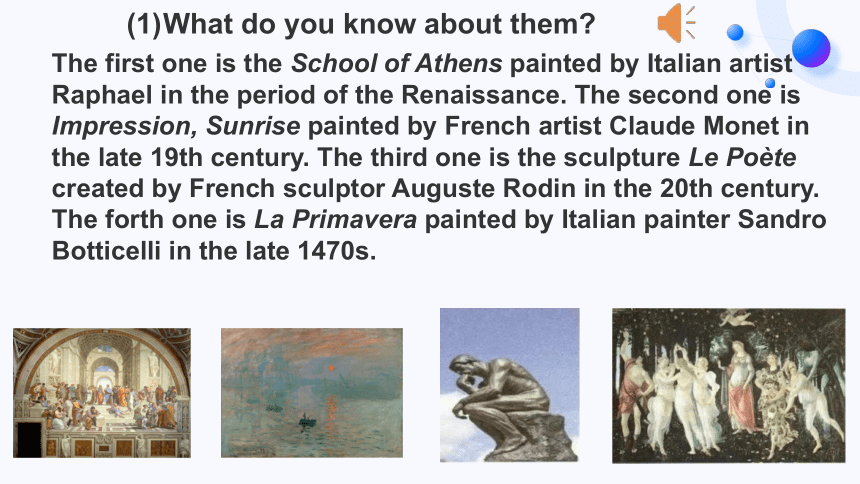
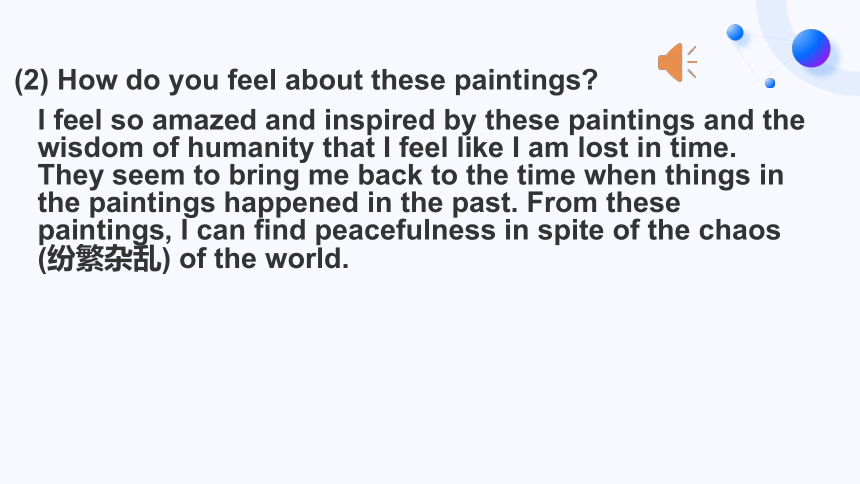
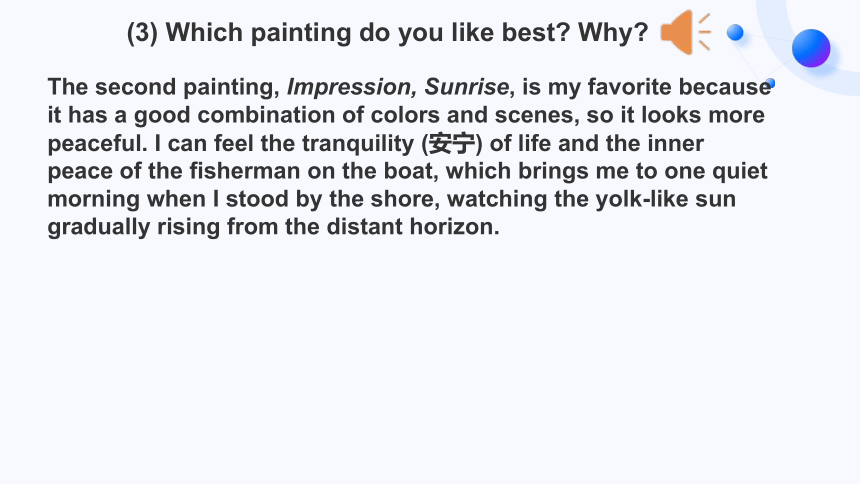
文档简介
(共30张PPT)
Unit 1 Art
Lesson 1 Reading and thinking (I)
1. What do you know about the
painting School of Athens Do you
know who painted it
The painting School of Athens is of the fresco (壁画) painting. It was painted between 1509 and 1511 on a wall by Raphael, an Italian painter and architect of the High Renaissance (文艺复兴全盛时期).
Look and Discuss
2. Who are those people in the
painting and what are they doing
The painting shows a gathering of famous Greek philosophers engaged in various activities, with Plato and Aristotle in the center.
Look and Discuss
3. Why do you think the painter
created this work of art What idea
did the painter want to convey
The painter created this work of art to praise the so-called “Golden Age” (黄金时代) in history and convey a yearning (渴望) for a free and open future.
Look and Discuss
4. How do you understand the quote
The viewer has good “taste”, as in the ability to choose and recognise things that are of good quality. However, to actually create such beauty is a higher ability, and this is what he considered to be the skill of the artist who creates art. Having good taste and appreciating art perhaps help one’s ability to create beauty.
Love of beauty is taste. The creation of beauty is art.
--- Ralph Waldo Emerson
Aims of this unit
In this unit, you will:
read about the history of Western painting and some famous artists;
hear and talk about works of art in different cultures;
write an announcement for an art exhibition;
explore the value of art.
Lesson 1 Reading and thinking (I)
In this lesson, you will:
1. read a passage about art and explore artists’ intention of creation;
2. know about the main idea, structure and stylistic feature of the
passage;
3. reorganize and compare the text information by using
visualized tool and relevant learning strategies to achieve the
goal of deep learning;
4. summarize the unique features of Western painting history
and paintings in different periods through detailed reading.
Aims of this lesson
Look at some paintings in different periods of art and discuss the following questions and try to put the paintings in chronological (按时间顺序的) order.
(1) What do you know about them
(2) How do you feel about these paintings
(3) Which painting do you like best Why
(4) Which painting came first How do you know
Lead-in
What do you know about them
The first one is the School of Athens painted by Italian artist
Raphael in the period of the Renaissance. The second one is
Impression, Sunrise painted by French artist Claude Monet in
the late 19th century. The third one is the sculpture Le Poète
created by French sculptor Auguste Rodin in the 20th century.
The forth one is La Primavera painted by Italian painter Sandro
Botticelli in the late 1470s.
(2) How do you feel about these paintings
I feel so amazed and inspired by these paintings and the wisdom of humanity that I feel like I am lost in time. They seem to bring me back to the time when things in the paintings happened in the past. From these paintings, I can find peacefulness in spite of the chaos (纷繁杂乱) of the world.
The second painting, Impression, Sunrise, is my favorite because
it has a good combination of colors and scenes, so it looks more
peaceful. I can feel the tranquility (安宁) of life and the inner
peace of the fisherman on the boat, which brings me to one quiet
morning when I stood by the shore, watching the yolk-like sun
gradually rising from the distant horizon.
(3) Which painting do you like best Why
(4) Which painting came first How do we know
They can be put into chronological order based on different contents and colors.
1. Read through the title, the first paragraph and the
subtitles. Then discuss the following questions.
(1) What is the passage about
(2) Who are the target readers of this passage
(3) Why does the author use subheadings
Read for structure and main idea
From the title, we can see the passage is about a short history of Western painting.
From paragraph one, we know the passage is going to introduce some important styles in Western painting and its development over the centuries.
(1) What is the passage about
(2) Who are the target readers of this passage
The target readers are probably those who are interested in art or the history of Western paintings.
The author uses subheadings as an explicit clue (明显的线索) to show different stages of Western painting clearly and readers can better understand its development in chronological order.
(3) Why does the author use subheadings
2. Glance at the whole passage and then try to identify the text
structure and draw a timeline to show how the information
is organized.
1. Look at the flow chart in Activity 2 on page 3 and answer
the questions.
(1) What is a flow chart
(2) What information should be included in the flow chart
Read for details
(1) What is a flow chart
A flow chart is a tool to show __________________________.
different processes or orders
(2) What information should be included in the flow chart
Information such as time, development stages, features of stages, and connectors etc. should be included in the flow chart.
2. Read the passage again and fill in the information of the
other three periods in the chart. The paragraph of The
Middle Ages is listed as an example.
Period Time Characteristics of the paintings Famous painters and their achievements
The Middle Ages
The Renaissance
Impressionism
Modern Art
5th to 15th century
primitive and two dimensional
the main characters were made larger
religious themes
Giotto di Bondone
His paintings showed real people in a real environment.
2. Read the passage again and fill in the information of the other three periods in the chart. The paragraph of The Middle Ages is listed as an example.
Period Time Characteristics of the paintings Famous painters and their achievements
The Middle Ages 5th to 15th century religious themes primitive and two dimensional Giotto di Bondone
His paintings showed real people in a real environment.
The Renaissance
Impressionism
Modern Art
Time
Characteristics of the paintings
Famous painters and their achievements
The Renaissance
Time
Characteristics of the paintings
Famous painters and their achievements
Impressionism
Modern Art
Time
Characteristics of the paintings
Famous painters and their achievements
Period Time Characteristics of the paintings Famous painters and their achievements
The Middle Ages 5th to 15th century religious themes primitive and two dimensional Giotto di Bondone
His paintings showed real people in a real environment.
The Renaissance 14th to 17th century use of perspective (透视法) use of oil paints subjects are people and the world around us Leonardo da Vinci, Michelangelo, Raphael
They produced some of the greatest art that Europe had ever seen.
Rembrandt
He gained a reputation as a master of shadow and light.
Period Time Characteristics of the paintings Famous painters and their achievements
Impressionism 19th to early 20th century convey light and movement not a detailed record full of light, shadow, color and life Claude Monet
He aimed to convey the subjective impression the scene gave him.
Renoir
He sought to show not just the outer image of his subjects, but their inner warmth and humanity as well.
Modern Art 20th century to today no longer show reality Picasso
He analyzed the shapes which existed in the natural world in a new way.
They began to ask the question, “What is art ”
Summary
In today’s class, we have:
learned about a short history of Western painting and explored artists’ intention of creation;
analyzed the main idea, structure and stylistic feature of the passage;
summarized and compared the text information by using visualized tool and relevant learning strategies;
summarized the unique features of Western painting history and paintings in different periods through detailed reading.
1. Read the reading tip “Identify change” and summarize all
the words and expressions that describe “change” in the text.
Homework
2. Surf the Internet and find several Western paintings you like
from different periods of art.
3. Finish the exercise 2 on page 4.
Unit 1 Art
Lesson 1 Reading and thinking (I)
1. What do you know about the
painting School of Athens Do you
know who painted it
The painting School of Athens is of the fresco (壁画) painting. It was painted between 1509 and 1511 on a wall by Raphael, an Italian painter and architect of the High Renaissance (文艺复兴全盛时期).
Look and Discuss
2. Who are those people in the
painting and what are they doing
The painting shows a gathering of famous Greek philosophers engaged in various activities, with Plato and Aristotle in the center.
Look and Discuss
3. Why do you think the painter
created this work of art What idea
did the painter want to convey
The painter created this work of art to praise the so-called “Golden Age” (黄金时代) in history and convey a yearning (渴望) for a free and open future.
Look and Discuss
4. How do you understand the quote
The viewer has good “taste”, as in the ability to choose and recognise things that are of good quality. However, to actually create such beauty is a higher ability, and this is what he considered to be the skill of the artist who creates art. Having good taste and appreciating art perhaps help one’s ability to create beauty.
Love of beauty is taste. The creation of beauty is art.
--- Ralph Waldo Emerson
Aims of this unit
In this unit, you will:
read about the history of Western painting and some famous artists;
hear and talk about works of art in different cultures;
write an announcement for an art exhibition;
explore the value of art.
Lesson 1 Reading and thinking (I)
In this lesson, you will:
1. read a passage about art and explore artists’ intention of creation;
2. know about the main idea, structure and stylistic feature of the
passage;
3. reorganize and compare the text information by using
visualized tool and relevant learning strategies to achieve the
goal of deep learning;
4. summarize the unique features of Western painting history
and paintings in different periods through detailed reading.
Aims of this lesson
Look at some paintings in different periods of art and discuss the following questions and try to put the paintings in chronological (按时间顺序的) order.
(1) What do you know about them
(2) How do you feel about these paintings
(3) Which painting do you like best Why
(4) Which painting came first How do you know
Lead-in
What do you know about them
The first one is the School of Athens painted by Italian artist
Raphael in the period of the Renaissance. The second one is
Impression, Sunrise painted by French artist Claude Monet in
the late 19th century. The third one is the sculpture Le Poète
created by French sculptor Auguste Rodin in the 20th century.
The forth one is La Primavera painted by Italian painter Sandro
Botticelli in the late 1470s.
(2) How do you feel about these paintings
I feel so amazed and inspired by these paintings and the wisdom of humanity that I feel like I am lost in time. They seem to bring me back to the time when things in the paintings happened in the past. From these paintings, I can find peacefulness in spite of the chaos (纷繁杂乱) of the world.
The second painting, Impression, Sunrise, is my favorite because
it has a good combination of colors and scenes, so it looks more
peaceful. I can feel the tranquility (安宁) of life and the inner
peace of the fisherman on the boat, which brings me to one quiet
morning when I stood by the shore, watching the yolk-like sun
gradually rising from the distant horizon.
(3) Which painting do you like best Why
(4) Which painting came first How do we know
They can be put into chronological order based on different contents and colors.
1. Read through the title, the first paragraph and the
subtitles. Then discuss the following questions.
(1) What is the passage about
(2) Who are the target readers of this passage
(3) Why does the author use subheadings
Read for structure and main idea
From the title, we can see the passage is about a short history of Western painting.
From paragraph one, we know the passage is going to introduce some important styles in Western painting and its development over the centuries.
(1) What is the passage about
(2) Who are the target readers of this passage
The target readers are probably those who are interested in art or the history of Western paintings.
The author uses subheadings as an explicit clue (明显的线索) to show different stages of Western painting clearly and readers can better understand its development in chronological order.
(3) Why does the author use subheadings
2. Glance at the whole passage and then try to identify the text
structure and draw a timeline to show how the information
is organized.
1. Look at the flow chart in Activity 2 on page 3 and answer
the questions.
(1) What is a flow chart
(2) What information should be included in the flow chart
Read for details
(1) What is a flow chart
A flow chart is a tool to show __________________________.
different processes or orders
(2) What information should be included in the flow chart
Information such as time, development stages, features of stages, and connectors etc. should be included in the flow chart.
2. Read the passage again and fill in the information of the
other three periods in the chart. The paragraph of The
Middle Ages is listed as an example.
Period Time Characteristics of the paintings Famous painters and their achievements
The Middle Ages
The Renaissance
Impressionism
Modern Art
5th to 15th century
primitive and two dimensional
the main characters were made larger
religious themes
Giotto di Bondone
His paintings showed real people in a real environment.
2. Read the passage again and fill in the information of the other three periods in the chart. The paragraph of The Middle Ages is listed as an example.
Period Time Characteristics of the paintings Famous painters and their achievements
The Middle Ages 5th to 15th century religious themes primitive and two dimensional Giotto di Bondone
His paintings showed real people in a real environment.
The Renaissance
Impressionism
Modern Art
Time
Characteristics of the paintings
Famous painters and their achievements
The Renaissance
Time
Characteristics of the paintings
Famous painters and their achievements
Impressionism
Modern Art
Time
Characteristics of the paintings
Famous painters and their achievements
Period Time Characteristics of the paintings Famous painters and their achievements
The Middle Ages 5th to 15th century religious themes primitive and two dimensional Giotto di Bondone
His paintings showed real people in a real environment.
The Renaissance 14th to 17th century use of perspective (透视法) use of oil paints subjects are people and the world around us Leonardo da Vinci, Michelangelo, Raphael
They produced some of the greatest art that Europe had ever seen.
Rembrandt
He gained a reputation as a master of shadow and light.
Period Time Characteristics of the paintings Famous painters and their achievements
Impressionism 19th to early 20th century convey light and movement not a detailed record full of light, shadow, color and life Claude Monet
He aimed to convey the subjective impression the scene gave him.
Renoir
He sought to show not just the outer image of his subjects, but their inner warmth and humanity as well.
Modern Art 20th century to today no longer show reality Picasso
He analyzed the shapes which existed in the natural world in a new way.
They began to ask the question, “What is art ”
Summary
In today’s class, we have:
learned about a short history of Western painting and explored artists’ intention of creation;
analyzed the main idea, structure and stylistic feature of the passage;
summarized and compared the text information by using visualized tool and relevant learning strategies;
summarized the unique features of Western painting history and paintings in different periods through detailed reading.
1. Read the reading tip “Identify change” and summarize all
the words and expressions that describe “change” in the text.
Homework
2. Surf the Internet and find several Western paintings you like
from different periods of art.
3. Finish the exercise 2 on page 4.
